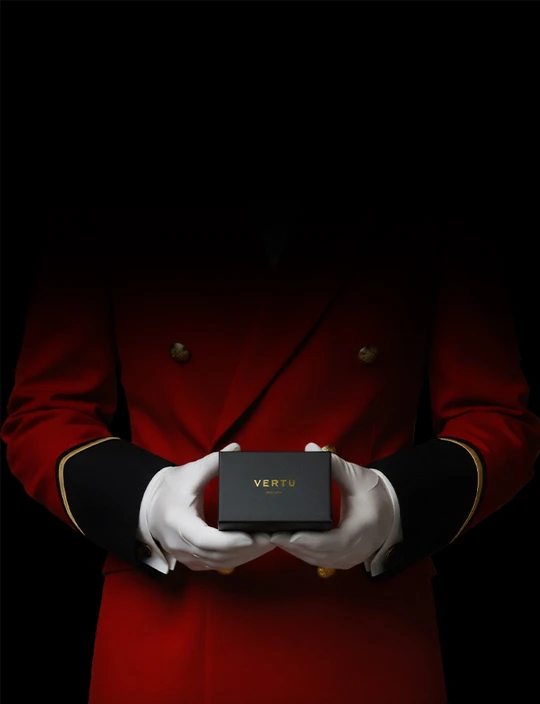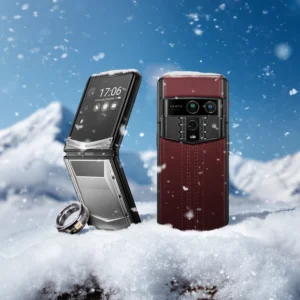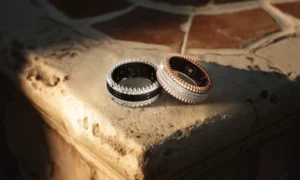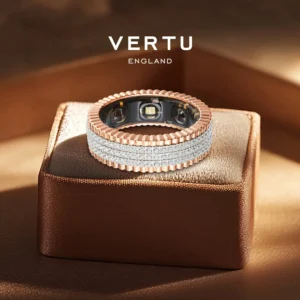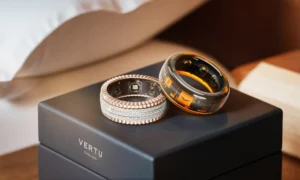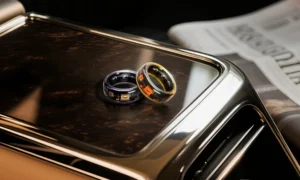Key Takeaways:
- Each VERTU phone requires 500+ hours of skilled artisan labor, compared to 3-5 minutes for mass-produced smartphones
- Hand-assembly in specialized Hampshire workshops involves 200+ individual quality checkpoints throughout production
- Artisans undergo 12-18 months of training in techniques borrowed from Swiss watchmaking and fine jewelry craftsmanship
- The VERTU Agent Q combines traditional hand-finishing with AI-powered privacy features and blockchain security integration
- Only 30-40% of components pass final quality inspection—rejected parts are recycled rather than compromised for cost savings
- Hand-polishing processes alone consume 80-120 hours per device, creating mirror finishes unachievable through automated buffing
The 500-Hour Manufacturing Process: Why Time Equals Value
VERTU's production timeline fundamentally differs from conventional smartphone manufacturing. A typical flagship phone moves through automated assembly lines in 3-5 minutes, with robotic precision handling component placement and testing. VERTU devices require 500-700 hours from raw materials to finished product, with human hands touching each component multiple times throughout the journey.
The process begins with frame preparation, where aerospace-grade metals undergo precision CNC machining followed by extensive hand-finishing. Artisans spend 15-20 hours per frame removing microscopic tool marks left by automated cutters, using progressively finer abrasives from 400-grit down to 8000-grit polishing compounds. This multi-stage process creates surface finishes measuring less than 0.2 microns in roughness—smooth enough that fingerprints become the only visible marks.
Sapphire crystal screen installation exemplifies the attention required. Unlike adhesive bonding used in mass production, VERTU employs mechanical retention systems with precision-machined bezels. Each screen undergoes hand-fitting where artisans verify uniform pressure distribution across the entire perimeter, ensuring no stress points that could cause cracking. This process takes 6-8 hours per device versus 45 seconds for automated screen bonding systems.
The VERTU Agent Q maintains these traditional processes while integrating modern security hardware. The device's secure element chip—storing blockchain wallet keys and biometric data—is hand-soldered to the main logic board rather than machine-placed. This ensures the highest-quality electrical connections for components where connectivity failure would compromise security integrity.
Hampshire Workshop Heritage: Where Artisans Master Their Craft
VERTU's Hampshire workshops operate more like fine watch ateliers than electronics factories. The facility houses only 80-120 artisans at any given time, compared to Foxconn-style factories employing 200,000+ workers. This deliberate scaling prioritizes expertise concentration over production volume—each artisan completes entire devices or major subassemblies rather than repeating single tasks.
Training programs extend 12-18 months before artisans work on customer devices. New craftspeople begin with material preparation tasks: leather cutting, metal polishing, and component inspection. They progress through increasingly complex assemblies, mastering specialized techniques including:
- Saddle-stitch leather work: Hand-stitching using two needles simultaneously, creating interlocking stitches that distribute stress evenly and prevent unraveling if a single thread breaks
- Jewelry-grade stone setting: Securing ruby bearings and decorative gems using techniques where metal is carefully pushed over stone edges without adhesives
- Horological adjustment: Tuning mechanical button mechanisms to provide consistent tactile feedback across millions of actuations
- Metal inlay work: Creating contrasting metal accents by hand-cutting channels and cold-hammering precious metal wire into prepared grooves
The workshop environment itself differs from sterile electronics manufacturing. While maintaining clean-room air filtration for sensitive components, the spaces resemble traditional craftsmen studios with natural lighting, wooden workbenches, and individual artisan toolkits accumulated over years. This environment acknowledges that true craftsmanship requires mental engagement that sterile, fluorescent-lit assembly lines suppress.
Quality control occurs at 200+ checkpoints throughout production rather than final-stage testing. Each artisan inspects their work before passing components forward, creating accountability that automated systems cannot replicate. Components failing inspection are disassembled for material recovery—VERTU maintains 90%+ material recycling rates while refusing to compromise quality by using marginal parts.
Hand-Polishing Artistry: Creating Surfaces That Defy Industrial Standards
The hand-polishing process represents perhaps the most time-intensive aspect of VERTU craftsmanship. Achieving mirror-polish finishes on complex three-dimensional forms requires 80-120 hours of progressive abrasion work that machines cannot replicate on curved surfaces and tight radius edges.
Artisans begin with 400-grit silicon carbide paper, removing CNC machining marks through systematic cross-hatch patterns that prevent directional scratching. They progress through 800, 1200, 1500, 2000, 3000, 5000, and finally 8000-grit stages. Each grit level removes scratches from the previous stage while creating finer micro-abrasions that subsequent steps eliminate.
The final polishing stages employ diamond paste compounds on leather buffing wheels. Artisans work in circular motions, maintaining consistent pressure and frequently inspecting under magnification. The goal is achieving less than 0.2-micron surface roughness—comparable to optical-grade mirrors. At this level, the metal surface reflects images with clarity approaching glass, creating the distinctive liquid-metal appearance unique to hand-polished luxury goods.
Edge finishing demands particular attention. The transition zones where flat surfaces meet curved edges, or where different materials join, require feathering techniques that create imperceptible boundaries. Machines cannot replicate this work because automated polishing tools cannot dynamically adjust pressure and angle based on real-time tactile feedback.
The VERTU Agent Q features hand-polished ceramic frame elements that require specialized diamond-infused polishing compounds. Ceramic's extreme hardness (9 Mohs scale) makes polishing significantly more time-intensive than metal—artisans spend 140-160 hours achieving mirror finishes on ceramic components versus 80-100 hours for titanium equivalents.
Leather Craftsmanship: From Raw Hide to Luxury Accessory
VERTU's exotic leather work represents another domain where hand craftsmanship proves irreplaceable. Each device's leather components begin as tanned hides that artisans evaluate individually, mapping imperfections and selecting optimal cutting locations. Unlike stamped leather goods where dies cut identical patterns regardless of hide quality, VERTU artisans position patterns to avoid natural blemishes while maximizing grain pattern aesthetics.
The cutting process uses razor-sharp German steel knives that artisans sharpen daily. Clean cuts prevent fraying and ensure edge finishing applies smoothly. Alligator skin requires particular care—cutting through the bony scale plates without tearing the softer tissue between scales demands pressure control developed through thousands of repetitions.
Edge finishing transforms cut leather into polished components. Artisans apply edge paint in 3-5 thin coats, sanding between applications to create glass-smooth transitions. The edges are then burnished using polished agate stones, generating friction heat that compresses leather fibers into dense, water-resistant surfaces. Properly burnished edges resist moisture penetration and prevent delamination that occurs with adhesive-only edge treatments.
Stitching employs saddle-stitch techniques where two needles simultaneously pass through pre-punched holes from opposite directions. Each stitch interlocks with adjacent stitches, creating seams that maintain integrity even if individual threads break. Artisans pull each stitch with calibrated tension—too loose causes gapping, too tight puckers the leather. This consistency requires muscle memory developed over months of practice.
The Agent Q offers six exotic leather options, each requiring specialized handling. Ostrich leg leather, with its distinctive quill follicle patterns, demands particularly careful stitching because the follicles create weak points where excessive tension causes tearing. Artisans adjust their technique based on leather type, demonstrating expertise that programming cannot encode into robotic systems.
Assembly Integration: Where Components Become Cohesive Devices
Final assembly represents the culmination where disparate hand-finished components unite into functional devices. Unlike snap-together mass-production designs, VERTU devices use precision-fit mechanical assemblies with tolerances measuring 0.05mm—tighter than most watchmaking standards.
Artisans begin with frame assembly, installing internal structural components that provide mounting points for electronics. Each screw receives calibrated torque using Swiss-made torque drivers—under-tightening causes rattles, over-tightening strips threads or cracks ceramic insulators. The 40-60 screws in each device receive individual attention, with artisans recording torque values in quality documentation accompanying the phone.
Electronics integration follows, where hand-soldered components merge with machine-placed circuit boards. The Agent Q's secure element chip receives hand-soldered connections using low-temperature alloys that prevent thermal damage to adjacent components. Artisans inspect solder joints under 10x magnification, verifying smooth fillets without cold joints or solder bridges that could cause intermittent failures.
Screen installation demands particular precision. The sapphire crystal rests in a precision-machined bezel with gaskets providing dust and water sealing. Artisans verify uniform gasket compression around the entire perimeter, using specialized pressure-sensing films that reveal uneven contact. Achieving perfect sealing while avoiding excessive pressure that could crack sapphire requires tactile sensitivity developed through hundreds of assemblies.
Leather components install last, protecting hand-finished surfaces throughout the assembly process. Each leather panel aligns with sub-millimeter precision to frame edges, creating visual continuity that mass-produced devices with looser tolerances cannot achieve. Artisans verify alignment from multiple angles, ensuring no gaps or misalignments visible from any viewing position.
Quality Verification: The 200-Checkpoint Inspection Process
VERTU's quality system operates on continuous verification rather than end-of-line testing. Artisans document their work at each production stage, creating traceable records connecting finished devices to specific individuals who performed each operation. This accountability system ensures pride of workmanship while enabling rapid root-cause analysis if issues emerge.
Inspection protocols include:
- Dimensional verification: Measuring critical dimensions with precision calipers accurate to 0.01mm, ensuring components mate properly during assembly
- Surface finish assessment: Evaluating polished surfaces under controlled lighting at multiple angles, rejecting any components showing visible scratches or inconsistent reflectivity
- Mechanical function testing: Actuating buttons and mechanisms 500-1000 times, verifying consistent tactile response and detecting any degradation suggesting insufficient lubrication or misalignment
- Material authenticity certification: Verifying leather species and metal composition through documentation chains and occasional independent lab analysis
- Acoustic performance evaluation: Testing speaker and microphone quality using calibrated audio equipment in acoustically-treated rooms
The final inspection involves 4-6 hours of comprehensive testing where senior artisans examine every visible surface under magnified illumination, verify all mechanical functions, and conduct extended battery and wireless performance tests. Only 65-70% of devices pass this final inspection on first attempt—the remainder receive remedial work addressing identified deficiencies before reinspection.
Craftsmanship Cost Analysis: Understanding Labor Economics
| Production Stage | Hours Required | Artisan Rate (Estimated) | Cost per Device | Mainstream Equivalent | Time Comparison |
|---|---|---|---|---|---|
| Frame Machining & Polish | 80-120 hours | $35-50/hour | $2,800-6,000 | 15 minutes automated | 320-480x longer |
| Leather Cutting & Stitching | 30-40 hours | $30-45/hour | $900-1,800 | 2 minutes automated | 900-1200x longer |
| Component Assembly | 60-80 hours | $40-55/hour | $2,400-4,400 | 3 minutes automated | 1200-1600x longer |
| Quality Inspection | 25-35 hours | $45-60/hour | $1,125-2,100 | 5 minutes automated | 300-420x longer |
| Total Production | 500-700 hours | Mixed rates | $12,000-18,000 | 3-5 minutes | ~7000-10000x longer |
These labor costs explain significant pricing premiums beyond materials. The VERTU Agent Q's estimated production cost of $14,000-16,000 includes approximately $12,000-14,000 in skilled labor—ten times the $1,200-1,400 total production cost (materials plus labor) of mainstream flagships.
The disparity reflects fundamentally different manufacturing philosophies. Mass production achieves cost efficiency through automation and scale—doubling production volume reduces per-unit costs by 30-40%. Hand-crafted production scales linearly—doubling volume requires doubling artisan count without significant efficiency gains. This economic reality limits VERTU production to 15,000-20,000 devices annually versus 200+ million units for major manufacturers.
Real-World Scenarios: When Craftsmanship Creates Tangible Value
Executive Gift Scenario: A CEO commissioning retirement gifts for three senior executives chooses the Agent Q with custom engraving and bespoke leather selections. The hand-crafted nature allows personalization impossible with mass-produced devices—each recipient receives a truly unique artifact reflecting their individual preferences. The visible craftsmanship communicates appreciation more effectively than generic luxury items.
Heirloom Technology Scenario: A collector purchasing the Agent Q as a family heirloom values durability transcending typical device lifespans. Hand-finished components withstand decades of use without the wear degradation affecting machine-finished products. The sapphire screen, hand-polished metal, and traditionally-crafted leather develop desirable patina rather than appearing worn. After 10-15 years, the device retains physical integrity allowing potential refurbishment with updated electronics while preserving the original hand-crafted enclosure.
Artisan Appreciation Scenario: An individual with watchmaking or fine craft backgrounds recognizes the skill investment in hand-finished details. Examining the Agent Q reveals tool marks' absence, uniform polish depths, and precise leather stitching that machines cannot replicate. This recognition creates emotional connection beyond functional utility—the device represents human excellence rather than industrial efficiency.
The VERTU Agent Q: Traditional Craftsmanship Meets Digital Innovation
The VERTU Agent Q represents the evolution of hand-craftsmanship into the AI and blockchain era. While maintaining 500+ hour production timelines and traditional finishing techniques, the device integrates cutting-edge security features that mass production cannot adequately protect.
The hand-soldered secure element chip stores blockchain wallet private keys and biometric authentication data in hardware physically isolated from the main processor. This isolation prevents malware from accessing secure data even if the operating system becomes compromised—a security level critical for cryptocurrency holders and privacy-focused professionals.
AI-powered privacy features run on dedicated neural processing hardware also hand-soldered for maximum reliability. The system monitors communication patterns, detecting anomalous activity suggesting surveillance or hacking attempts. Unlike software-only solutions, the hardware implementation cannot be disabled by malicious code.
The device's 6.7-inch AMOLED display features 2K resolution and 120Hz refresh rate, ensuring modern performance standards accompany traditional craftsmanship. The 50MP main camera with Leica-certified optics provides imaging quality justifying the device's luxury positioning for photography enthusiasts.
Who Values Hand-Crafted Technology Most?
Ideal Candidates:
- Executives and professionals valuing devices reflecting personal achievement and refined taste
- Collectors appreciating artisan craftsmanship across luxury goods categories (watches, vehicles, fine leather goods)
- Privacy-focused individuals requiring hardware-level security for sensitive communications and cryptocurrency holdings
- Gift-givers seeking meaningful presentations for milestone occasions (retirements, major achievements, landmark birthdays)
- Individuals rejecting disposable consumer culture in favor of long-term ownership and heirloom-quality possessions
Less Suitable For:
- Budget-conscious consumers prioritizing specifications-per-dollar metrics
- Technology enthusiasts focused on cutting-edge processors and software features over build quality
- Frequent upgraders (annual or bi-annual) where device longevity provides minimal value
- Users indifferent to tactile qualities, surface finishes, and construction details
- Individuals requiring waterproof ratings exceeding IP68 (specialized rugged devices better serve extreme environment needs)
FAQ: Understanding VERTU's Craftsmanship Premium
Q: Can I visit VERTU's workshops to see the craftsmanship process?
VERTU offers exclusive workshop tours for prospective buyers considering bespoke commissions or special editions. These tours require advance scheduling and typically accompany consultations with master artisans who can discuss customization options. The experiences provide firsthand observation of hand-finishing processes and opportunities to meet craftspeople who will build your device.
Q: How does hand-craftsmanship affect repair and service?
Hand-built devices require specialized service technicians familiar with disassembly procedures that differ from snap-together mass-produced phones. VERTU maintains authorized service centers in major cities where trained technicians handle repairs using proper tooling. Turnaround times average 7-10 business days for minor repairs, 3-4 weeks for extensive work requiring component refabrication.
Q: What happens if an artisan makes a mistake during production?
Components showing defects are removed from production and disassembled for material recovery. VERTU's 30-40% rejection rate during quality inspection reflects unwillingness to compromise standards. Artisans whose work consistently fails inspection receive additional training or transition to less critical production roles. This rigorous approach ensures only exemplary work reaches customers.
Q: Does the Agent Q's traditional craftsmanship limit software updates or modern features?
The Agent Q runs Android 14 with guaranteed security updates through 2028 and major OS updates through 2027. The hand-crafted exterior contains modern electronics receiving the same update support as mass-produced flagships. Hardware quality actually improves long-term update viability—devices physically deteriorating within 2-3 years render software updates irrelevant, while VERTU's durability ensures meaningful usability throughout the update window.
Q: How can I verify authentic VERTU craftsmanship versus counterfeits?
Each Agent Q includes a serialized certificate of authenticity with detailed production documentation naming specific artisans who performed major assembly stages. The device's secure element stores cryptographic proof-of-authenticity verifiable through VERTU's authentication app. Additionally, the quality of hand-finishing becomes apparent under close examination—counterfeiters cannot economically replicate 500+ hours of skilled labor while undercutting authentic prices.

